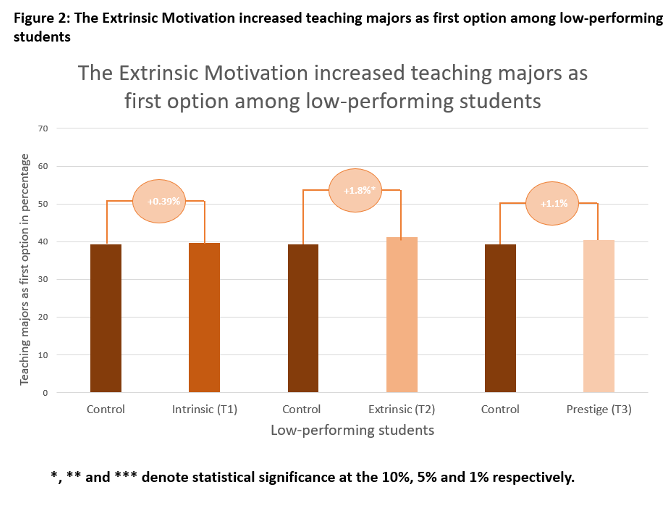A communication campaign to increase students’ enrollment in education majors in Chile Context

Context
A critical issue in many Latin American countries is the insufficient supply of qualified teachers for public schools. Public education is a crucial factor for equalizing opportunities for students from different socioeconomic backgrounds, and the shortage of quality teachers in the school system jeopardizes the proper delivery of educational services. Some governments have adopted successful but insufficient policies to attract high-quality teachers, like offering scholarships for high-performing high-school students, increased wages, and stricter admission requirements to the profession. While the supply of quality teachers remains low, representing an obstacle to providing high-quality education, this poses an opportunity to test behavioral science tools to motivate people to enter the teaching profession, especially high-performing high school students.
The project
To increase the participation of high-performing students in the teaching profession, the IDB partnered with Elige Educar (a Chilean NGO focused on improving the status of the teaching profession) to design and implement a behavioral intervention targeting high school students in Chile in their last year of high school. Building on Elige Educar’s ongoing communication campaign to improve the teaching profession’s social standing, an experiment was implemented to evaluate the most effective strategies to attract high-performing students to the teaching profession. The intervention, which appealed to students’ motivations for pursuing a major in education, took place between November 2019 and February 2020.
Behavioral Barriers
Stereotypes: Overgeneralized beliefs or perceptions about a group of people used to make inferences on a single group member. Stereotypes are often resistant to revision. In this case, high-performing students might perceive a career in education as a career of low prestige and low income.
Lack of information: People may lack relevant information, for instance, because the information is difficult to obtain, scarce, or hard to understand. High school students might not be fully informed about the steps to pursue a major in education or the benefits (monetary and non-monetary) of a teaching career.
Intention-Action Gap: People do not always do what they intend to do. Factors that often explain the gap are procrastination, missed opportunities, doubts, emotionally charged situations, the difficulty of tasks, and a lack of straightforward steps to move forward. In this case, we focus on motivating students who had previously stated that they might be interested in pursuing a career in teaching.
Behavioral Tools
Framing: Given the tendency to draw different conclusions depending on how information is presented, the desired options can be given to emphasize the relevant part of the information, as well as to highlight the positive or negative aspects of a decision, leading an option to be perceived as more or less attractive. In this case, a communication campaign was implemented that addressed various motivations involved in the decision to pursue a major in education. For some, the information was framed in terms of the monetary benefits of the career or in terms of non-monetary benefits. For others, the information was framed in terms of the social status that comes with the career.
Intervention Design
Aiming to ease the barriers of stereotypes and lack of information around the teaching career and its benefits, the team partnered with the NGO Elige Educar to design and implement a behavioral intervention to motivate high-performing high school students to pursue a teaching career. This project built on Elige Educar’s ongoing communication campaign to improving the teaching profession’s social standing by exploiting students’ motivations to pursue a major in education.
The intervention was based on weekly emails to students encouraging them to choose education as a major by highlighting three types of motivation: intrinsic, extrinsic, and prestige based. There was a treatment based on each type of motivation. Treatment 1 (T1), for intrinsic motivation, highlighted non-monetary values added by the profession like the satisfaction of influencing children’s development. Treatment 2 (T2), for extrinsic motivation, highlighted recent improvements in working conditions and monetary benefits for teachers. Treatment 3 (T3), for prestige-based motivation, reinforced the idea that teaching is valued by society and key for the country’s development. The control group received purely informative content about the requirements to earn a degree in education.
Students received 22 emails: 17 email newsletters containing information on their corresponding treatment and five email newsletters containing information on the University Entrance Examination (Prueba de selección universitaria, PSU) and the application process. These five emails were the same for all students participating. In total, 81,118 students participated in this project and were randomly assigned to one of three treatments or control groups. They were high school students in their final year who had stated in a previous survey that they might be interested in pursuing a career in teaching.
The intervention lasted four months, from November 6, 2019 to February 25, 2020. On the latter date, students received results for the PSU administered in January 2020 and subsequently applied to their preferred majors. Six weeks after students took the PSU, test results, information from a college application that includes a list of 10 major options, and choice of major were measured.
As the goal of this behavioral intervention was to motivate high-performing high school students to pursue careers in education, the main outcome used to measure the intervention’s effect was college applications to teaching programs by high-performing students. Secondary outcomes were whether they selected a teaching degree as their first preference in the list and the proportion of teaching degrees in their list of preferences.
Challenges
The main challenge with online tools, especially with messaging systems like emails, is that delivery does not guarantee that messages are opened and read by the recipients even if messages are successfully delivered.
Results
The intervention had negative to null effects on high-performing students.
- Making the non-monetary values added by the profession salient (T1) backfired. As Figure 1 shows, the intrinsic motivation treatment reduced applications to teaching majors among high-performing students (those who scored above the median PSU score). It also reduced the selection of a teaching degree as their first preference and the inclusion of education majors in their list of preferences.
- Reinforcing the idea that teaching is valued by society and key for the country’s development (T3) reduced the selection of a teaching degree as the first preference for high-performing students, and it did not affect applications to teaching majors among high-performing students (see Figure 1 on the inclusion of education majors in those students’ list of priorities.
- Highlighting recent improvements in working conditions and monetary benefits for teachers did not affect high-performing students.
- There was no effect of intrinsic motivation treatment (T1) or the prestige-based motivation treatment (T3) on low-performing students. However, Figure 2 shows that the extrinsic motivation treatment (T2) increased the selection of a teaching degree as the first preference among low-performing students (those who scored below the median PSU score). Thus, the extrinsic motivation treatment (T2) was the only treatment with positive effects for any segment of the population.


Policy Implications
The results from the intervention show that motivating all types of students with the same information (i.e., showing students from high- and low-income households the same information) could have unintended consequences. By exploring the possible mechanism behind these results, the study finds that highlighting non-monetary benefits to students from high-income households could make them focus their attention on features the profession lacks in comparison to others, such as more competitive wages, and thus less likely to choose teaching majors. On the other hand, highlighting monetary benefits makes students from low-income households focus their attention on improved wages in the teaching profession, and thus more likely to choose teaching majors.
One way to target these unintended consequences by policymakers is to collect individual information from the students in order to customize campaign content to motivate students to apply to education majors.
